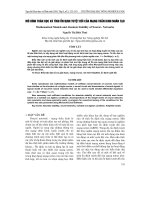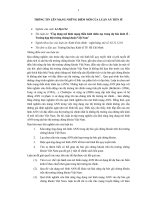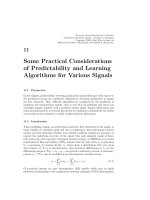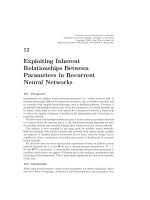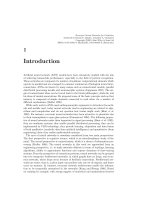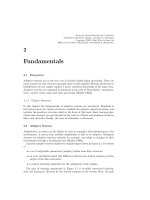Mạng thần kinh nhân tạo cho phân lớp màu sắc part 6 ppt
Bạn đang xem bản rút gọn của tài liệu. Xem và tải ngay bản đầy đủ của tài liệu tại đây (194.98 KB, 11 trang )
310
EPS=1.0;
do
{
EPS/=2.0;
tol1=1.0+EPS;
} while(tol1>1.0);
EPS=(float)sqrt((double)EPS);
df=(float *)malloc(N*sizeof(float));
dfp=(float *)malloc(N*sizeof(float));
S=(float *)malloc(N*sizeof(float));
xt=(float *)malloc(N*sizeof(float));
dfun(x,df,N);
for(i=0;i<N;i++)
S[i]=df[i];
gotoxy(1,6);
q=fun(x);
printf(" Initial value of error function=%f",q);
iter=0;
while(iter<no_iter)
{
if(kbhit()!=0)
{
if(getch()==ESC);
return;
}
iter++;
/* test convergence. */
test=0.0;
for(i=0;i<N;i++)
test +=(float)fabs((float)df[i]);
if(test < eps1)
{
printf("\nConvergence by gradient test.");
break;
}
/* If df*S<0.0 restart. */
test=1.0;
for(i=0;i<N;i++)
{
311
if( df[i]*S[i]>0.0){
test=-1.0;
break;
}
}
if(test<0.0)
{
for(i=0;i<N;i++)
S[i]=df[i];
}
/* Save previous gradient vector.*/
for(i=0;i<N;j++)
dfp[i]=df[i];
/* Line Search. */
bracket(0.01, 0.001,&a,&b,fun,x,xt,S,N);
astar=Brent(a,b,fun,eps2,x,xt,S,N);
/* Adjust variables.*/
for(i=0;i<N;i++)
x[i]-=astar*S[i];
dfun(x,df,N);
sum1=sum2-0.0;
for(i=0;i<N;i++)
{
sum1+=dfp[i]*dfp[i];
sum2+=df[i]*df[i];
}
sum=sum2/sum1;
for(i=0;i<N;i++)
S[i]=sum*S[i]+df[i];
q=fun(x);
gotoxy(1,7);
printf(" Error function=%f at iteration # %-
5d",q,iter);
}
printf("\nNumber of iterations = %d \n",iter);
free(S);
free(xt);
}
/* Function evaluation for line search. */
312
float f( float alpha, float (*fun)(float *),float
*x, float *xt,
float *S, int N)
{
int i;
float q;
for(i=0;i<N;i++)
xt[i]=x[i]-alpha*S[i];
q=fun(xt);
return q;
}
/* Function to bracket the minimum of a single
variable function. */
void bracket(float ax, float dx,
float *a,float *b,float (*fun)(float *),
float *x, float *xt, float *s, int N)
{
float y1,x1,x0,y0,x2,y2;
int iter;
x0=ax ;
x1=x0+dx;
y0=f(x0,fun,x,xt,s,N);
y1=f(x1,fun,x,xt,s,N);
if(y1>=y0)
{
dx=-dx;
x1=x0+dx;
y1=f(x1,fun,x,xt,s,N);
}
dx=2.0*dx;
x2=x1+dx;
y2=f(x2,fun,x,xt,s,N);
iter=0 ;
while(y2<y1)
{
313
iter++;
dx=2.0*dx;
x0=x1;
y0=y1;
x1=x2;
y1=y2;
x2=x1+dx;
y2=f(x2,fun,x,xt,s,N);
}
*a=x0;
*b=x2;
}
/* Brent's algorithm for obtaining the minimum
of a single variable function. */
#define CGOLD 0.381966
float Brent(float ax, float bx , float (*fun)
(float *) , float TOL,
float *x,float *xt, float *S, int N)
{
float
a,b,u,v,w,xx,e,fx,fv,fu,fw,xm,tol1,tol2,c,r,q,p;
int iter;
a=ax;
b=bx;
v=a+CGOLD*(b-a);
w=v;
xx=v;
e=0.0;
fx=f(xx,fun,x,xt,S,N);
fv=fx;
fw=fx;
c=0.0;
iter=0;
while(iter<100)
{
iter++;
314
xm=0.5*(a+b);
tol1=EPS*(float)fabs((double)xx)+TOL/3.0;
tol2=2.0*tol1;
if((float)fabs((double)(xx-xm))<=(tol2-0.5*(b-a)))
{
return xx;
}
if((float)fabs((double)e)>tol1)
{
r=(xx-w)*(fx-fv);
q=(xx-v)*(fx-fw);
p=(xx-v)*q-(xx-w)*r;
q=2.0*(q-r);
if(q>0.0) p=p;
q=(float)fabs((float)q);
r=e;
e=c;
/* is parabola acceptable.*/
if(((float)fabs((double)p)<(float)fabs((double)(0.5
*q*r)))||
(p > q*(a-xx))||
(p < q*(b-xx)))
{/* fit parabola.*/
if(q==0.0) q=1.e-10;
c=p/q;
u=xx+c;
/* f must not be evaluated too close to a or b. */
if( (((u-a)<tol2))|| ((b-u)<tol2) )
c=((xm-xx)>0.0) ? tol1 : -tol1;
goto l2;
}
else goto l1;
}
else
{ /* A tû lÖ vµng step. */
l1: if(xx>=xm) e=a-xx;
else e=b-xx;
c=CGOLD*e;
}
315
/* update a,b,v,w, and x. */
l2: if(fabs((double)c)>=tol1) u=xx+c;
else u=xx+((c>0.0)?tol1:-tol1);
fu=f(u,fun,x,xt,S,N);
if(fu<=fx)
{
if(u>=xx) a=xx;
else b=xx;
v=w;
fv=fw;
w=xx;
fw=fx;
xx=u ;
fx=fu;
continue;
}
else
{
if(u<xx) a=u;
else b=u;
}
if((fu<=fw)||(w==xx))
{
v=w;
fv=fw;
w=u;
fw=fu;
continue;
}
if((fu<=fv)||(v==xx)||(v==w))
{
v=u;
fv=fu;
}
}
}
Để kiểm tra chơng trình 12.3 chúng ta lấy dữ liệu dùng chơng trình
12.2 từ ảnh "AUTHOR.IMG". Các màu ở đây đợc chia thành các sắc màu
liên tiếp nhau. Dữ liệu đã có sẵn trên đĩa, chứa trong file "TINT2.DAT", dữ
316
liệu có thể biểu diễn trên sơ đồ màu nh hình 12.13. Chơng trình có thể bị
ngắt tại bất kỳ lúc nào bằng cách ấn phím ESC. Kết quả của hệ thống sẽ
đợc lu một cách tự động trong một file đặc biệt có tên ban đầu do ngời
dùng đặt. Nếu sau đó bạn muốn tiếp tục với "đào tạo", bạn cần quay trở về
chơng trình chính, nhng lần này trả lời "y" khi chơng trình hỏi bạn: Bạn
có muốn dùng các trọng số đợc đào tạo trớc không? Lý do phải có phím
ESC là đào tạo đòi hỏi một thời gian dài và bạn muốn ngắt chơng trình,
dùng máy tính vào các việc khác. Để áp dụng, chúng ta dùng một một
perceptron ba lớp (cũng có thể dùng perceptron hai lớp), với lớp che khuất
đầu tiên có tám nút, lớp che khuất thứ hai có bốn nút, và lớp ra chỉ có một
nút. Lớp vào, tất nhiên là chỉ có hai nút, một cho x và một cho y - các biến
của biểu đồ màu. Tín hiệu ra của hệ thống sẽ là 1 nếu dữ liệu biểu diễn cho
sắc màu skin, và 0 cho các trờng hợp còn lại. Chơng trình bắt đầu bằng
một số tính ngẫu nhiên giữa 0 và 1, và đòi hỏi gần 17,000 phép lặp và hơn 5
giờ tính toán trên máy 486-25 MHz. Sai lệch giảm xuống từ 32 xuống
0.0057. File chứa hệ thống này, chẳng hạn nh, số các lớp, số các điểm
trong mỗi lớp, và trọng số có sẵn trên đĩa dới tên " WTSST.DAT".
Hình 12.13 "TINT2.DAT" dùng thử mạng thần kinh.
Bây giờ chúng ta cần phát triển một chơng trình để kiểm tra cách làm
việc thực sự của hệ thống. Liệt kê cho tất cả các thuật toán này trong một
chơng trình đợc cho ở dới đây.
Chơng trình 12.4 TESNLYE.C. Kiểm tra.
317
/* Program 12.4 "TESNLYE.C". Testing a multilayer
network.*/
/************************************
* Developed by M.A.Sid-Ahmed. *
* ver. 1.0, 1992. *
* @ 1994 *
*************************************/
/* Program for testing a multi-layer perceptron. */
void float fun(float *);
#include <stdio.h>
#include <stdlib.h>
#include <math.h>
#include <conio.h>
int M,*NL,*NS,L;
int *d;
float *xp,*y,*net,*delta,theta;
void main()
{
float *w,q,xt;
int i,j,N,xd,ind,Nt;
char file_name[14],file_name2[14],ch;
FILE *fptr,*fptr2;
clrscr();
printf("\nEnter file_name for weights >");
scanf("%s",file_name);
fptr=fopen(file_name,"r");
if(fptr==NULL)
{
printf("file %s does not exist. ",file_name);
exit(1);
}
fscanf(fptr,"%d ",&L);
NL=(int *)malloc(L*sizeof(int));
NS=(int *)malloc((L-2)*sizeof(int));
318
for(i=0;i<L;i++)
fscanf(fptr,"%d ",&NL[i]);
NS[0]=NL[0]*NL[1];
for(i=1;i<(L-2);i++)
NS[i]=NS[i-1]+NL[i]*NL[i+1];
N=NS[L-3]+NL[L-2]*NL[L-1]; /* Total # of
weights. */
/* Assigning memory for weights. */
w=(float *)malloc(N*sizeof(float));
for(i=0;i<N;i++)
fscanf(fptr,"%f ",&w[i]);
fscanf(fptr,"%f ",&theta);
fclose(fptr),
Nt=0 ;
for(i=1;i<L;i++)
Nt+=NL[i]; /* Total number of neurals. */
/* Assigning memory to *net, *z, *delta. */
net=(float *)malloc(Nt*sizeof(float));
y=(float *)malloc(Nt*sizeof(float));
delta=(float *)malloc(Nt*sizeof(float));
printf("\nEnter file - name containing training
data >");
scanf("%s",file_name2);
fptr2=fopen(file_name2,"r");
if(fptr2==NULL)
{
printf("file %s does not exist. ", file_name);
exit(1);
}
/* Determining the size of the data. */
M=0; ind=1;
while(1)
{
for(i=0;i<NL[0];i++)
{
319
if((fscanf(fptr2,"%f ",&xt))==EOF) /* input
data. */
{ ind=0;
break;
}
}
if(ind==0)
break;
for(i=0;i<NL[L-1];j++) /* desired output. */
fscanf(fptr2,"%d ",&xd);
M++;
}
printf("\n# of data points=%d",M);
rewind(fptr2);
/* Assigning memory to *xp, *d */
xp=(float *)malloc((M*NL[0])*sizeof(float));
d=(int *)malloc((M*NL[L-1])*sizeof(int));
/* Reading in the data. */
for(i=0; i<M; i++)
{
for(j=0;j<NL[0];j++)
fscanf(fptr2,"%f ",&xp[j*M+i]);
for(j=0;j<NL[L-1];j++)
fscanf(fptr2,"%d ",&d[j*M+i]);
}
fclose(fptr2);
gotoxy(1,7);
printf
("Press any key to see network response for next
input.");
fun(w);
}
extern float *net,*w,*delta,*y;
extern int *d;
extern int *NS,*NL;
/* Generating the function. */
320
void fun(float *w)
{
int i,j,k,m,n,Nt1,Nt2;
float error, E;
for(k=0;k<M;k++)
{
for(i=0;i<NL[1];i++) /* From input layer to first
*/
{ /* hidden layer. */
net[i]=0.0;
for(j=0;j<NL[0];j++)
net[i]+=w[i+j*NL[1]]*xp[j*M+k];
net[i]+=theta;
E=(float)exp(-(double)net[i]);
y[i]=1.0/(1.0+E);
}
Nt1=NL[1]; Nt2=0;
for(n=2;n<L;n++) /* From layer n-1 to layer n.
*/
{
for(i=0;i<NL[n];i++)
{
m=Nt1+i;
net[m]=0.0;
for(j=0;j<NL[n-1];j++)
net[m]+=w[NS[n-2]+i+j*NL[n]]*y[j+Nt2];
net[m]+=theta;
E=(float)exp(-(double)net[m]);
y[m]=1.0/(1.0+E);
}
Nt1+=NL[n];
Nt2+=NL[n-1];
}
gotoxy(1,10);
for(i=0;i<NL[L-1];i++) /* Calculating the error.
*/
{
error=d[k+i*M]-y[Nt2+i];
printf("response to data # %d",k+1);

